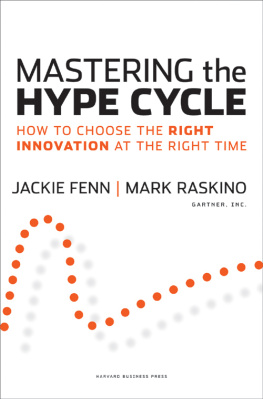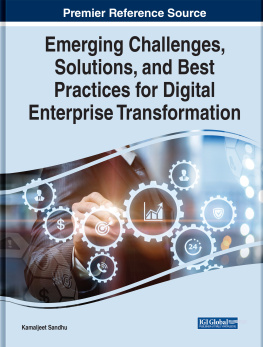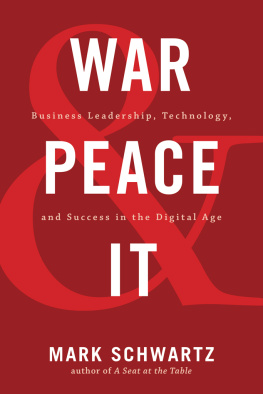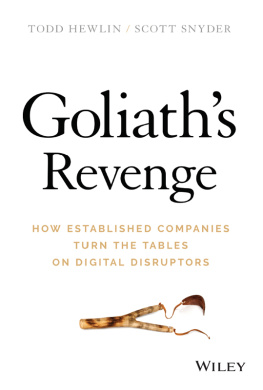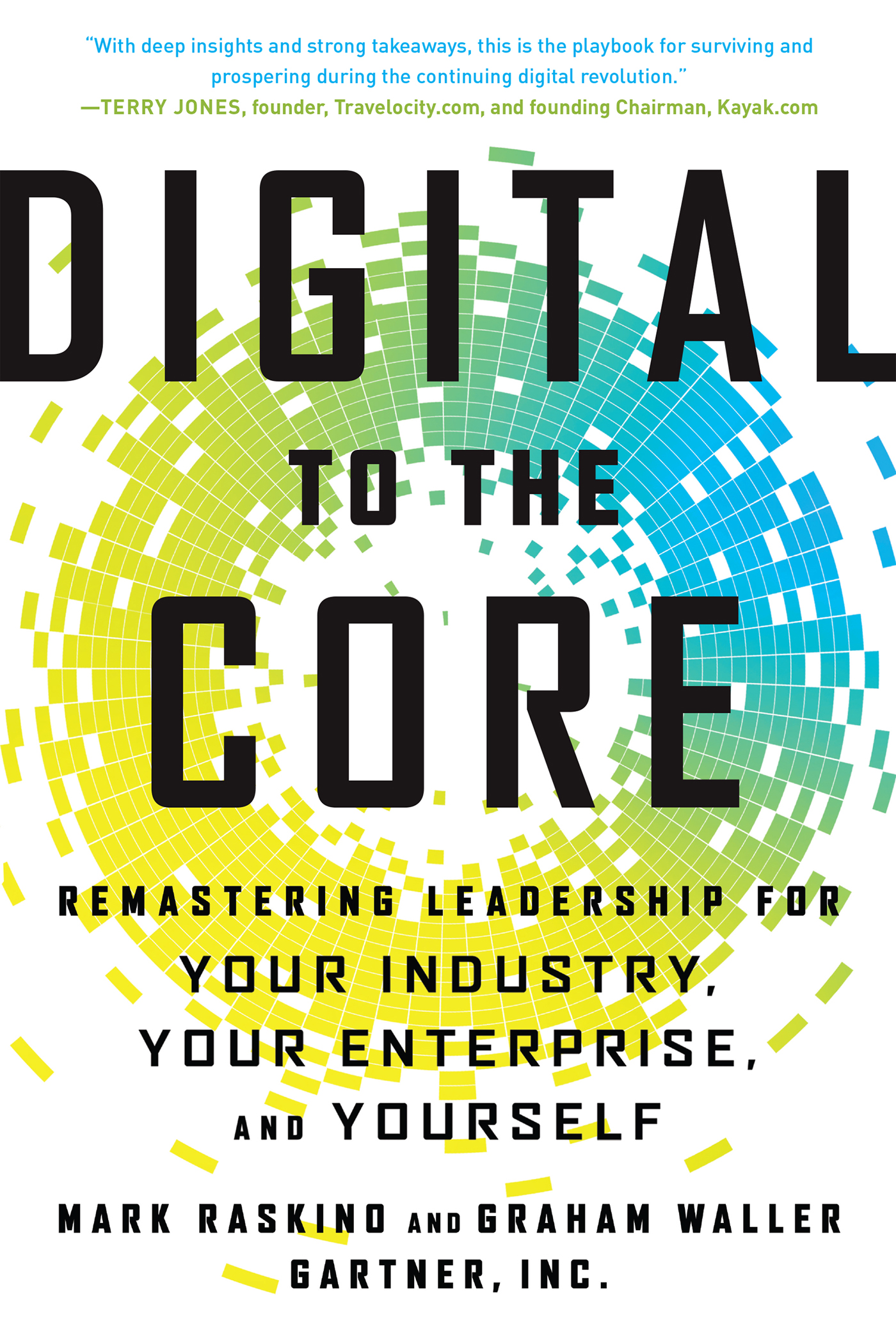First published by Bibliomotion, Inc.
39 Harvard Street
Brookline, MA 02445
Tel: 617-934-2427
www.bibliomotion.com
Copyright 2015 by Gartner, Inc.
All rights reserved. No part of this publication may be reproduced in any manner whatsoever without written permission from the publisher, except in the case of brief quotations embodied in critical articles or reviews.
Library of Congress Cataloging-in-Publication Data
Raskino, Mark, author.
Digital to the core : remastering leadership for your industry, your enterprise, and yourself / Mark Raskino and Graham Waller.
pages cm
ISBN 978-1-62956-073-1 (hardback) ISBN 978-1-62956-074-8 (ebook) ISBN 978-1-62956-075-5 (enhanced ebook)
1. Information technologyManagement. 2. Technological innovationsManagement. 3. Leadership.I. Waller, Graham, author. II. Title.
HD30.2.R37 2015
658'.05dc23
2015026965
From Mark
To Pauline, Ben, and Danny
From Graham
Thanks to those closest to my coreAlex, Daniel, Jackie, John, Louise, Patty, and Sheilayou humble and inspire me every day
R afael Nadal, looking relaxed in sweatpants and a baseball cap, strode up to the net on a tennis court at the Babolat headquarters in Lyon, France. As Nadal played the first few strokes, Eric Babolat, CEO of the French tennis equipment company, watched with nervous anticipation. In April 2012, Babolat had invited Nadal to test the revolutionary new Connect racquet, which digitally captures a players forehands, backhands, smashes, and servesand sends that data directly to a smartphone or tablet. Richly colored charts told Nadal how much topspin he put on each stroke and whether he hit the ball with the racquets sweet spot.
It was like a kid seeing a toy for the first time, Eric Babolat recounted. You could see it in his eyes, Babolat said of Nadal. Hes a professional player, he has played every day of his life. For the first time he was seeing new imagesthe data of his game. Before there was tennis without data, now there is tennis with data. Its not a new page in the book. Its a new book.
Babolats Play racquet contains accelerometer and gyroscope sensors, a digital microprocessor, Bluetooth wireless communications, and a battery. All of these components weigh just fifteen grams and fit inside the handle. A player picking up the conventional version of the same racquet cannot tell the difference; they feel exactly the same. Whats more, the technology isnt available only to Grand Slam professional players. Anyone can buy the racquet for $300 to $400.
This is digital to the coreradical new technology flowing into a company and penetrating right to the core of its productthe racquetand to the player and the game. The game of tennis can trace its roots back to twelfth-century France. So perhaps it will surprise you to know that until 2013, this revered sportplayed, loved, and watched by many millions of people the world overwas defined with only thirty rules. One year after Nadal picked up the Play racquet, in July 2013, Eric Babolat sat in a hotel near the Arc de Triomphe in Paris waiting for a crucial decision from the International Tennis Federation (ITF) Annual General Meeting. Its like the United Nations, he recalled. You have people from everywhere, with all languages. They vote for a lot of resolutions.
Babolats digital innovation helped to literally change the rules of the game. The rule change was crucial to the companys future, because tennis is big business. The size of the tennis industry is $5.55 billion a year in the United States alone,
Taking Digital to the Core for Every Business
A quick sketch of Babolats history will help you see why this type of digital disruption isnt reserved for greenfield start-ups alone. Every business, no matter how old, has the opportunity and the ability to digitally remaster its products and services. Babolats story showcases a long history of innovation.
In 1998, Eric Babolat became the fifth-generation leader to run the family-owned company, and he was determined to build on its historic That invention led the Babolat company eventually to focus wholly on sports racquets. More than a century later, building on that legacy of technological innovation, Eric Babolat is full of passion and pride when he speaks about the worlds first and most advanced digital tennis racquet.
He sits in the same 1870s buildings that his great-grandfather used, nondescript and easily missed on the quiet Lyon side street, marked only by a small plaque that guides you to the right doorway. Once youre inside, however, the lobby tells you about the revolution going onvideo screens show the connected racquet in action and data projectors paint slogans with light onto the tables: Innovation, No Guts, No Glory, No Limits. Its all about a piece of sports equipment that senses every strike of the ball, calculates and interprets whats happening, and wirelessly sends that information to the players smartphone or tablet for later analysis.
This individual product revolution is both fascinating and impressive, and we will return to it throughout this book. But its just one story of how products and servicesincluding yourswill be digitally remastered over the next few years. We wrote this book for CEOs, CIOs, CDOs, strategy officers, and other executivesas we will see in , the entire C-level leadership team must be involved. Over the past several years, we have surveyed thousands of CIOs and CEOs to understand their priorities and concerns, and weve worked with CIOs in companies and governments around the globe in their pursuit of digital business. We realized that executives from businesses outside the tech industry need to better comprehend the profound digital disruption now taking placewith more changes on the horizonand understand how to take action. Often, they are unsure of where to start or how to stay oriented as change builds upon change.
To delve into the secrets of todays successful digital leaders, we supplemented Gartners vast research base and annual executive survey data with more than thirty interviews of CIOs, CEOs, chief digital and data officers, and other C-level executives from a range of global organizations including Babolat, GE, Ford, Quicken Loans, Publicis, the U.K. government, Tory Burch, BBVA, Indias Bharatiya Janata Party, Tokio Marine Insurance, Seoul National University Bundang Hospital, and more. Digital to the Core is the result of this research and our many conversations with CIOs in the Gartner community, and it explores how three disruptive digital forces will require you to remaster leadership of your industry, your enterprise, and yourself.
Before we describe these three forces, lets set some context by describing the power and potential of digital business.
Whats Different About Digital Business?
Do you assume that everyone is already doing digital? If so, then consider that many businesspeople today have a fuzzy view of what digital business is, what the progress stages look like, and how big the gap between companies is. In fact, its quite alarming how far behind some companies really are. In the 2014 Gartner CEO and Senior Executive Survey, we asked CEOs to answer the following question in their own words: What does digital business mean in the context of your company and industry? The responses varied widely, and we found that some companies are far ahead of others.
Industry differences did not explain the wide range of responses. Some responses toward the bottom left of It will be hard for CEOs to lead such growth if they dont understand digital clearly.


